The European Union (EU), as a regional economic and political bloc, has consistently highlighted the interconnectedness of trade, environmental sustainability, and sustainable development in its policymaking and global governance approach. This linkage reflects the EU’s commitment to achieving economic growth while simultaneously promoting social equity and environmental protection. The EU has shaped global discussions on these issues by integrating sustainability principles into its trade policies, aligning its internal regulatory frameworks with global environmental standards, and advocating for a holistic approach to development that combines economic, environmental, and social dimensions.
1. EU’s Integration of Sustainable Development in Trade Policies
The EU has long recognized that trade and sustainability cannot be treated as separate issues. The realization that economic growth must be pursued without undermining natural resources or human rights has influenced the design of EU trade policies.
1.1 Sustainable Development Goals (SDGs)
The EU’s trade agreements increasingly reflect its commitment to the United Nations Sustainable Development Goals (SDGs). The EU has integrated environmental standards and human rights provisions into several bilateral and multilateral trade agreements. For instance, in trade negotiations with Mercosur (Argentina, Brazil, Paraguay, and Uruguay), the EU emphasized the inclusion of environmental protection clauses to address issues such as deforestation, biodiversity, and climate change.
- Green Trade Agreements: The EU has pushed for the inclusion of environmental sustainability clauses in all of its trade agreements. For example, the EU-Canada Comprehensive Economic and Trade Agreement (CETA) includes commitments on climate action, environmental protection, and labor standards. Such trade agreements are seen as a tool to promote global sustainable development by aligning economic activity with environmental goals.
- Carbon Border Adjustment Mechanism (CBAM): The EU has introduced mechanisms like the Carbon Border Adjustment Mechanism (CBAM), which aims to place a carbon price on goods imported into the EU based on their carbon footprint. This policy directly connects trade with the environment by incentivizing countries outside the EU to adopt greener technologies and reduce carbon emissions, thus supporting global efforts to mitigate climate change.
1.2 Trade-Environment Linkage in the EU’s Common Trade Policy
The EU’s Common Trade Policy (CTP) also reflects the belief that trade policies should contribute to environmental sustainability. The EU has pursued trade agreements that uphold environmental protection while fostering economic exchanges. Notably, the European Green Deal has become a foundational element of the EU’s broader policy framework, influencing both trade policy and its commitment to achieving carbon neutrality by 2050.
- Environmental Conditionality in Trade: The EU has increasingly incorporated environmental conditionality into its trade agreements. This has been particularly evident in the EU’s negotiation strategies with developing nations, wherein environmental and labor conditions are included as preconditions for accessing the EU market. While such conditions can sometimes be contentious, they reflect the EU’s stance that sustainable trade must promote both environmental protection and social welfare.
2. The EU and Environmental Standards
The EU is one of the global leaders in setting environmental standards that influence both its domestic policies and its trade agreements. These standards are designed to promote sustainable development by integrating environmental protection into economic activities.
2.1 EU’s Internal Environmental Regulations
Internally, the EU has developed an extensive set of environmental regulations that govern trade practices. These regulations are designed to minimize the negative impacts of industrialization and trade on the environment. Key policies include:
- Circular Economy Action Plan: The EU Circular Economy Action Plan aims to reduce waste, promote recycling, and encourage sustainable consumption patterns, aligning with the EU’s overarching goal of sustainable development.
- EU Emissions Trading System (ETS): The EU Emissions Trading System is a cornerstone of the EU’s climate policy. It uses a market-based approach to encourage companies to reduce greenhouse gas emissions. This system also influences the EU’s trade policies, as it sets standards for industries involved in the global supply chain.
2.2 Global Environmental Leadership
The EU has positioned itself as a global advocate for environmental sustainability. It has been a strong proponent of international environmental agreements, such as the Paris Agreement on climate change, and has played a pivotal role in shaping global environmental governance.
- Climate Diplomacy: The EU uses trade and climate diplomacy to promote its environmental agenda globally. For example, the EU’s climate diplomacy efforts are evident in its leadership role in international negotiations and its pressure on other countries to adopt binding environmental standards. The EU has also extended its leadership in environmental technology, exporting green technologies to developing countries and integrating sustainability into global trade discussions.
3. Linkages with Sustainable Development
Sustainable development in the context of the EU encompasses economic growth, social inclusion, and environmental protection. The EU has recognized that economic development must be balanced with the responsible use of natural resources and the equitable distribution of benefits among society.
3.1 The European Green Deal and Sustainable Development
One of the most significant contemporary initiatives linking trade, environment, and sustainable development is the European Green Deal. This ambitious policy framework aims to make the EU’s economy climate-neutral by 2050. It seeks to transform various sectors, such as energy, transport, agriculture, and industry, to reduce their environmental footprint while ensuring that social inclusion remains at the core of the transformation.
- Social Cohesion and Just Transition: The Green Deal emphasizes the importance of a just transition that leaves no one behind. By aligning trade with sustainable development, the EU aims to create new economic opportunities in green sectors, while also ensuring that communities and regions that may be adversely affected by the transition are supported through social investment and training programs.
3.2 Sustainable Development in External Relations
The EU also integrates sustainable development into its external relations, particularly in its development cooperation policies. The EU’s Development Cooperation Instrument (DCI) aims to support developing countries in achieving the SDGs, with a specific focus on environmental sustainability, poverty reduction, and good governance.
- Trade and Aid Linkages: In some trade agreements, the EU links market access to the implementation of sustainable development practices in partner countries. This approach aims to encourage developing nations to prioritize sustainable agriculture, renewable energy, and climate change adaptation.
4. Challenges and Criticisms
Despite the EU’s commitment to linking trade, environment, and sustainable development, several challenges persist. These include:
- Global Resistance: Not all countries, particularly developing nations, support the EU’s emphasis on environmental standards in trade agreements. They argue that such policies may limit their economic growth and development by imposing additional costs.
- Internal Divergence: Within the EU itself, there are tensions between member states that prioritize economic growth and those that are more committed to environmental protection. This divergence can complicate the EU’s ability to adopt and enforce comprehensive policies.
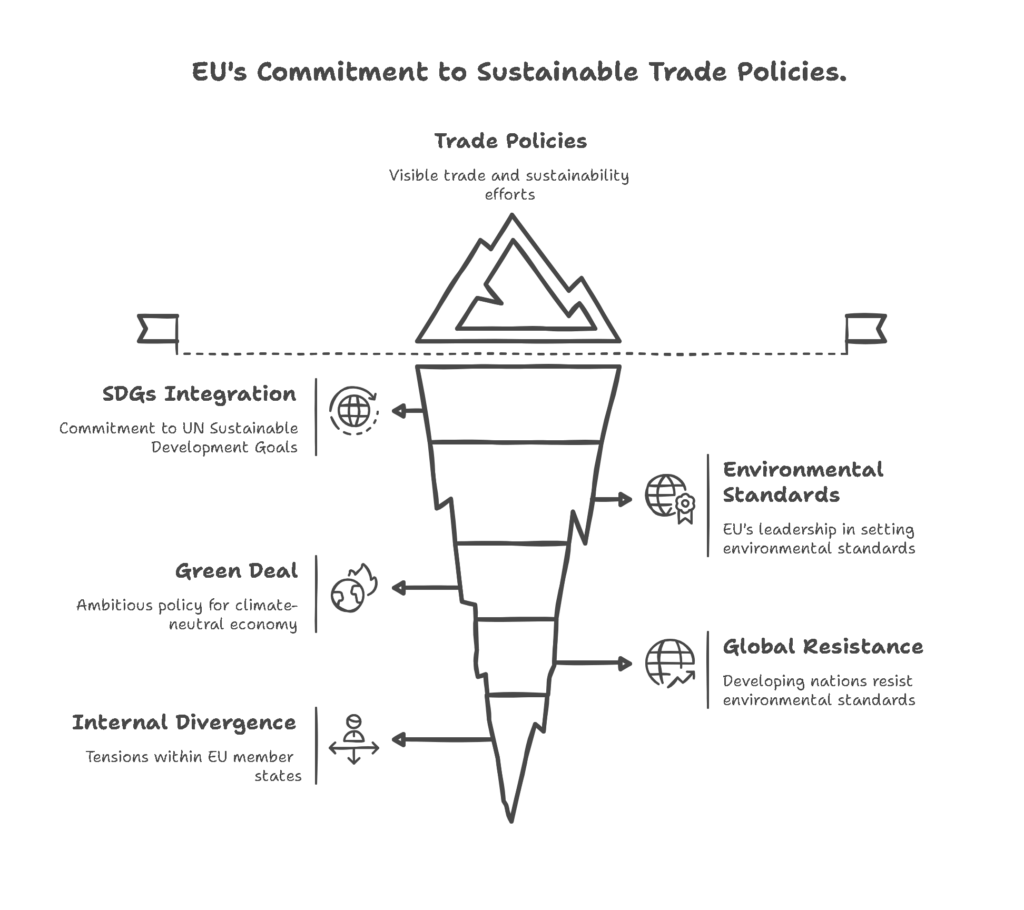
5. Conclusion
In conclusion, the European Union has been at the forefront of integrating trade, environmental sustainability, and sustainable development in its global strategy. The EU’s efforts to link these elements reflect a commitment to a holistic approach to development that prioritizes long-term environmental and social well-being. However, challenges remain, particularly in reconciling economic and environmental objectives within both the EU and in its relations with the global South. As the global community continues to confront climate change and resource depletion, the EU’s ability to harmonize trade, environment, and sustainable development will remain central to its leadership on the world stage.



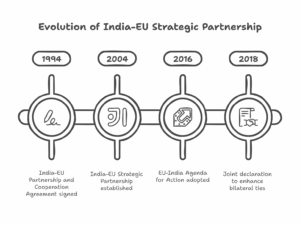

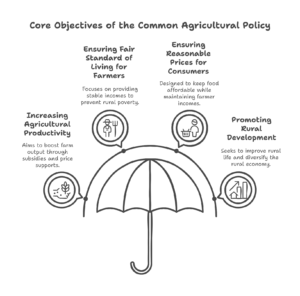
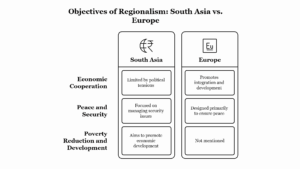
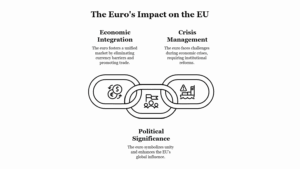
Leave a Reply